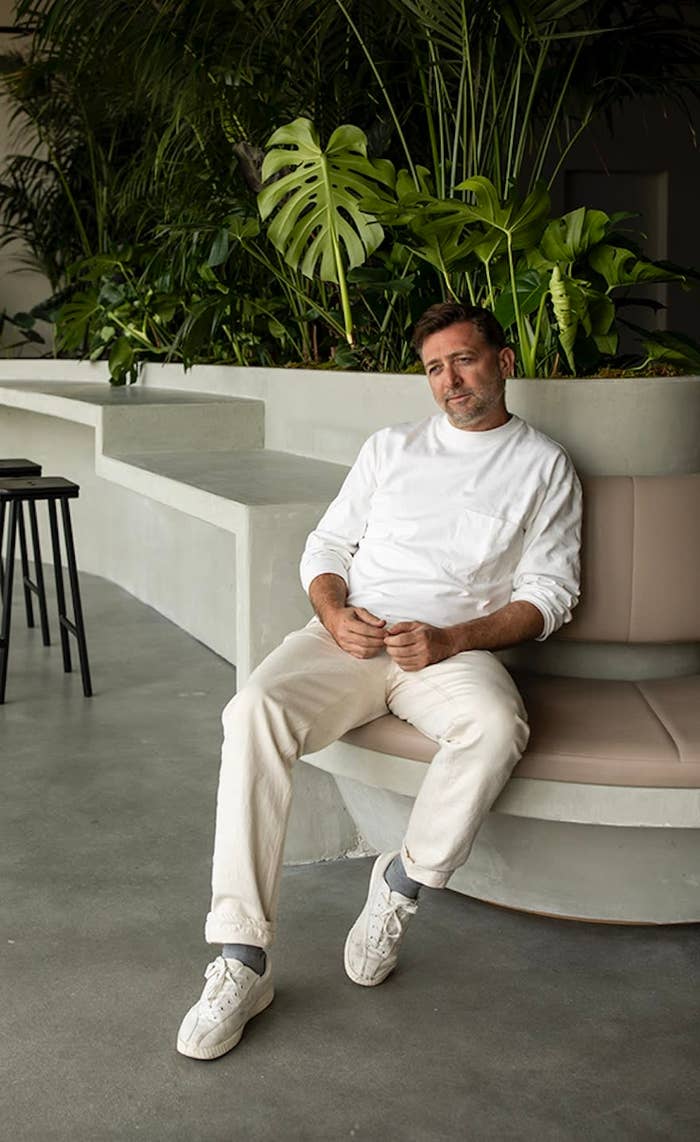
This past Sunday, the most viewed television event of the year so far took place––and so did the Super Bowl. Rihanna’s Super Bowl LVII halftime show reportedly generated more views than the actual football game, with the return of Ms. Fenty garnering 118.7 million compared to the Super Bowl’s 113 million overall viewers. It goes without saying that Rihanna’s performance was really the main event, and stage designer Willo Perron made sure to create a platform fit for a billionaire superstar.
“I always start designing shows with thinking about who the person is that I am designing the show for, who the audience is and simultaneously what are the technical restraints might be,” the Canadian designer tells Complex. “And obviously, I have done shows with Rihanna since 2008, so I am pretty familiar with how she moves and you know, all the things Rihanna.”
Perron is the godfather of creative directors, overseeing the stage designs of some of the most iconic tours in music, from the floating Ferrari for Drake’s Aubrey and the Three Migos Tour to architecting Kanye West’s Glow in the Dark tour and more. Perron and Rihanna have worked together extensively in the past, with Perron being the architect behind her ANTI World Tour stage design as well. That 2016 tour was actually the last time Rihanna was on the road, and being that this was his first time working the Super Bowl, Perron knew he wanted to have the singer presented in the most illustrious way possible for her return.
“I wanted to do something that was a lot more intentional and very kind of direct hence the sort of like UV orange and chrome platforms and such,” Perron explained of his approach to the elevated stage design.
An interesting challenge comes with designing a stage fit for a football game (or in this case, several floating stages) for the Super Bowl halftime show, and it has everything to do with the grass. It was reported that the NFL shelled out $800,000 for the specially preserved greenery, and they were doing everything in their power to protect it. After the show, production designer Bruce Rodgers said that the halftime show team had to keep the heavy stage off the field in order to keep the grass as pristine as possible before the players returned. “This is also what struck the idea of the flying component because that never had to touch the grass—which was kind of the problem-solve for our limited amount of rolling carts,” Perron said.
While Rihanna’s vocals were captivating by themselves, the hovering platform she performed on caught viewers’ attention immediately. From a birds-eye view, it revealed that the floating neon squares that she and her dancers stood on formed the shape of an umbrella to fit her iconic track of the same name when she performed it. And despite Rihanna being afraid of heights, Perron was able to make her comfortable thanks to his skill at suspending massive objects in the air—look to the Canadian designer finding a way to have Drake’s real yellow Ferrari float above the crowd during his tour the Migos for proof.
Following Rihanna’s stunning Super Bowl halftime show performance, we connected with the architect via email to get details behind the elevated stage design, its ideation, and the logistics of the show.

Walk me through the visual message you were trying to convey with your design, and how specific aspects of the stage play into that message.
I don’t really know if there is really a message so much as being able to do a polished aesthetic to a thing that’s normally grandiosity with pyro and lifts. I wanted to do something that was a lot more intentional and very kind of direct hence the sort of like UV orange and chrome platforms and such.
You have an extensive history working with Rihanna, most notably during her ANTI World Tour. It’s been a while since she’s graced a stage; how did you try to accommodate that with this year’s Super Bowl stage design?
There’s no difference in how she’s performing or what we have done in the past. I always start designing shows with thinking about who the person is that I am designing the show for, who the audience is and simultaneously what are the technical restraints might be––and obviously, I have done shows with Rihanna since 2008, so I am pretty familiar with how she moves and you know, all the things Rihanna.
It was reported that preserving the grass on the field was very important to the NFL, and that the stage had to be half the size of the ones in years past. How did these constraints play into your ideation and design?
Technically it wasn’t half the size of previous years, what it was is that we had half the rolling carts of previous years. So the halftime show with Dr. Dre and Snoop Dogg last year was 40 rolling carts, and we had 20. So you know, kind of why I did it in this sort of runway format was the best use of space to be as grand with the limited amount of physical carts we were able to roll onto the grass. That’s both because the entry point of the venue is limited and also the actual grass itself, because it’s actually real grass. This is also what struck the idea of the flying component because that never had to touch the grass—which was kind of the problem-solve for our limited amount of rolling carts.
We noticed that the hovering platforms were in the shape of an umbrella from a bird’s-eye view. That’s so dope; when did that idea come about in the ideation process?
Well, it’s in the shape of an umbrella during Rih’s “Umbrella” song. But—they constantly move and change positions all through the show. And you know, maybe a bit on the nose for the umbrella thing, but we figured you know, if it was any time to be on the nose.
How closely did you and Rihanna work together on the design? What did she want to include?
It always starts with me doing a really big brush stroke moodboard, and we go through it together and she picks things that she likes and from that sort of extrapolate an aesthetic for the show and present that to her, and then we have some back and forth. There’s a lot of freedom in stopping and starting ideas.
Between choreography, lighting, setlist, and stage design, there are many moving parts to this. How collaborative is the process of putting the Super Bowl stage together?
Oh, super collaborative. Everybody down to engineering and costume, it has to be onboard to try to achieve one vision. Yeah, and it just sort of gets layered in. I think the very first thing is I start with the big brush stroke mood boards, and the stage design with the look and feel and then that merges into everything from engineering, choreography to lighting.
From ideation to completion, how long did it take to create this stage design?
Around five to six months.

